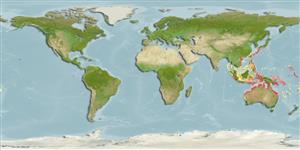>
Eupercaria/misc (Various families in series Eupercaria) >
Labridae (Wrasses) > Bodianinae
Etymology: Choerodon: Greek, choiros = a pig + odous = teeth (Ref. 45335); referrring to the prominent anterior canines of the species in this genus (Ref. 116605).
More on author: Richardson.
Environment: milieu / climate zone / depth range / distribution range
Écologie
marin récifal. Subtropical
Indo-West Pacific: Western Australia to Queensland. Reported to range from Sri Lanka to Papua New Guinea, north to the Ryukyu Islands, south to New Caledonia (Ref. 9710).
Taille / Poids / Âge
Maturity: Lm ? range ? - ? cm
Max length : 70.0 cm TL mâle / non sexé; (Ref. 2334)
Épines dorsales (Total): 13; Rayons mous dorsaux (Total): 7; Épines anales 3; Rayons mous anaux: 10. Body with about 5 very faint broad dusky bands dorsally on side in most freshly preserved specimens. A large pale spot often present below posterior end of caudal fin in adults. No darky spot present on side below fifth or sixth dorsal-fin spine. Adults with second prominent anterior canine approximately same size as first, second canine slanted dorsally. (Ref 9823)
Adults inhabit sand and rubble areas of reef flats and flat shelf bottoms of outer reef slopes (Ref. 9710). They enter very shallow water, and feed mainly on mollusks. Oviparous, distinct pairing during breeding (Ref. 205).
Life cycle and mating behavior
Maturité | Reproduction | Frai | Œufs | Fécondité | Larves
Oviparous, distinct pairing during breeding (Ref. 205).
Randall, J.E., G.R. Allen and R.C. Steene, 1990. Fishes of the Great Barrier Reef and Coral Sea. University of Hawaii Press, Honolulu, Hawaii. 506 p. (Ref. 2334)
Statut dans la liste rouge de l'IUCN (Ref. 130435)
Menace pour l'homme
Harmless
Utilisations par l'homme
Aquarium: Commercial
Plus d'informations
RéférencesAquacultureProfil d'aquacultureSouchesGénétiqueElectrophoresesHéritabilitéPathologiesTraitementNutrientsMass conversion
CollaborateursImagesStamps, Coins Misc.SonsCiguateraVitesseType de nageSurface branchialeOtolithesCerveauxVision
Outils
Articles particuliers
Télécharger en XML
Sources Internet
Estimates based on models
Preferred temperature (Ref.
123201): 24.6 - 29.3, mean 28.4 °C (based on 1845 cells).
Phylogenetic diversity index (Ref.
82804): PD
50 = 0.5000 [Uniqueness, from 0.5 = low to 2.0 = high].
Bayesian length-weight: a=0.01318 (0.00582 - 0.02984), b=3.05 (2.86 - 3.24), in cm total length, based on LWR estimates for this (Sub)family-body shape (Ref.
93245).
Niveau trophique (Ref.
69278): 3.6 ±0.50 se; based on food items.
Résilience (Ref.
120179): Faible, temps minimum de doublement de population : 4,5 à 14 années (Preliminary K or Fecundity.).
Fishing Vulnerability (Ref.
59153): Moderate to high vulnerability (48 of 100).
Nutrients (Ref.
124155): Calcium = 19.6 [9.5, 38.6] mg/100g; Iron = 0.484 [0.269, 0.903] mg/100g; Protein = 19.4 [16.5, 21.6] %; Omega3 = 0.19 [0.11, 0.33] g/100g; Selenium = 17.3 [8.7, 33.0] μg/100g; VitaminA = 47.5 [14.6, 188.4] μg/100g; Zinc = 0.759 [0.516, 1.245] mg/100g (wet weight);
